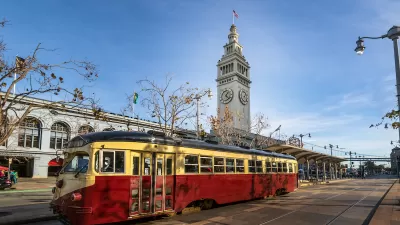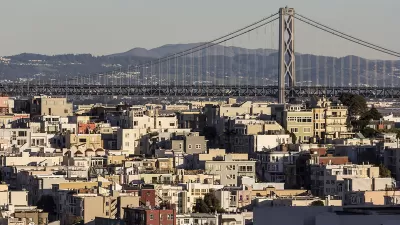With rapidly increasing gaps between costs and funding, the transit systems serving the San Francisco bay area are on an unsustainable path. Egon Terplan offers six solutions to ensure they serve bay area residents long into the future.
With operating costs rising and service falling for the 10% of regional residents who rely on transit to take them back and forth to work every day, and the legions of occasional users, bay area transit is in an unsustainable downward spiral. Terplan summarizes the challenges facing the system thus: "Wages and fringe benefits account for more than three-quarters of the operating and maintenance costs of transit, and the cost of fringe benefits in particular is rising fast. At the same time, budget shortfalls, unpredictable revenues and service cuts are degrading the quality of public transportation."
And the long term impact of a failed transit system would be detrimental to the entire region. "In short, the Bay Area cannot remain economically competitive, nor meet its goals of cutting greenhouse gas emissions, without a transit system that does a better job of getting people where they need to go in a cost-effective and efficient manner."
Interpreting the findings of a recent study called the Transit Sustainability Project (TSP), conducted by the Metropolitan Transportation Commission (MTC), the San Francisco Planning and Urban Research Association (SPUR), of which Egon Terplan is Regional Planning Director, has produced suggestions for overhauling the system based on improvements to six key areas: funding, speeds, fares, competition, information and maps. Each of these suggestions is explained in detail in the article.
Recent news suggests progress is already being made on at least one suggestion, to "[p]roduce a single transit map for the Bay Area and move toward common branding."
FULL STORY: Six Ideas for Saving Bay Area Transit

Alabama: Trump Terminates Settlements for Black Communities Harmed By Raw Sewage
Trump deemed the landmark civil rights agreement “illegal DEI and environmental justice policy.”

Planetizen Federal Action Tracker
A weekly monitor of how Trump’s orders and actions are impacting planners and planning in America.

The 120 Year Old Tiny Home Villages That Sheltered San Francisco’s Earthquake Refugees
More than a century ago, San Francisco mobilized to house thousands of residents displaced by the 1906 earthquake. Could their strategy offer a model for the present?

Ken Jennings Launches Transit Web Series
The Jeopardy champ wants you to ride public transit.

BLM To Rescind Public Lands Rule
The change will downgrade conservation, once again putting federal land at risk for mining and other extractive uses.

Indy Neighborhood Group Builds Temporary Multi-Use Path
Community members, aided in part by funding from the city, repurposed a vehicle lane to create a protected bike and pedestrian path for the summer season.
Urban Design for Planners 1: Software Tools
This six-course series explores essential urban design concepts using open source software and equips planners with the tools they need to participate fully in the urban design process.
Planning for Universal Design
Learn the tools for implementing Universal Design in planning regulations.
Clanton & Associates, Inc.
Jessamine County Fiscal Court
Institute for Housing and Urban Development Studies (IHS)
City of Grandview
Harvard GSD Executive Education
Toledo-Lucas County Plan Commissions
Salt Lake City
NYU Wagner Graduate School of Public Service





























